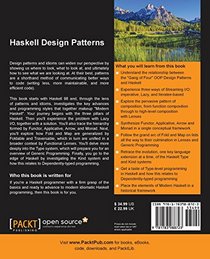Search -
Haskell Design Patterns
Haskell Design Patterns
Author:
Take your Haskell and functional programming skills to the next level by exploring new idioms and design patternsAbout This BookExplore Haskell on a higher level through idioms and patternsGet an in-depth look into the three strongholds of Haskell: higher-order functions, the Type system, and Lazy evaluationExpand your understanding of Haskell a... more »
Author:
Take your Haskell and functional programming skills to the next level by exploring new idioms and design patternsAbout This BookExplore Haskell on a higher level through idioms and patternsGet an in-depth look into the three strongholds of Haskell: higher-order functions, the Type system, and Lazy evaluationExpand your understanding of Haskell a... more »
ISBN-13: 9781783988723
ISBN-10: 178398872X
Publication Date: 11/2/2015
Pages: 157
Rating: ?
ISBN-10: 178398872X
Publication Date: 11/2/2015
Pages: 157
Rating: ?
0 stars, based on 0 rating
Publisher: Packt Publishing - ebooks Account
Book Type: Paperback
Members Wishing: 0
Reviews: Amazon | Write a Review
Book Type: Paperback
Members Wishing: 0
Reviews: Amazon | Write a Review
Genres:
- Computers & Technology >> Programming >> Software Design, Testing & Engineering >> Software Development
- Computers & Technology >> Programming >> Functional
- Computers & Technology >> Hardware & DIY >> Design & Architecture
- Science & Math >> Mathematics >> Pure Mathematics >> Functional Analysis




